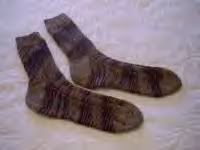As much as I love knitting with wool it's fun to knit with "exotic" fibers and I don't mean shredded muppet! Beautiful linen fits the bill perfectly!
Altho not the easiest fiber to knit with, linen produces a super strong, hardwearing, light, soft fabric that is super easy to care for and actually improves with age! In addition, to me, the only thing cooler than linen in the heat of summer is well, naked! I have many linen blouses in my closet and I'm thrilled that I can knit with it too!
Linen is a cellulose fiber, meaning it is derived from plant matter.
Linen comes from the Flax Plant
 Almost every part of the plant can be utilized.....
Almost every part of the plant can be utilized..... Various parts of the plant are used to make fabric, dye, paper, medicines, fishing nets and soap and because the flower of the flax plant is one of the few true BLUE flowers occurring in nature, flax is often used as ornamental shrubbery.
Various parts of the plant are used to make fabric, dye, paper, medicines, fishing nets and soap and because the flower of the flax plant is one of the few true BLUE flowers occurring in nature, flax is often used as ornamental shrubbery.
 Even the seeds are utilized! The seeds can be processed with a solvent to produce Linseed or Flaxseed Oil which is commonly used in painting and varnishing.
Even the seeds are utilized! The seeds can be processed with a solvent to produce Linseed or Flaxseed Oil which is commonly used in painting and varnishing.
Linseed oil can also be cold pressed for human consumption (ask Barry Bonds, hee!) and is one of the most concentrated plant sources of the omega-3 alpha linolenic acid which is thought to have qualities to prevent heart disease!
Flax fiber is amongst the oldest fiber crops in the world. The use of flax for the production of linen goes back 5000 years. There are pictures on tombs and temple walls from ancient Egypt that depict flowering flax plants!
To make linen, flax fiber is extracted from the skin of the stem of the flax plant. The plant is pulled from the root to maximize long fiber length which produces much higher quality linen. Once harvested the stems are immersed in water in a process, called retting, which causes the non-fibrous material to rot off, leaving only the long fibrous strands. The fibers are then refined and spun into linen that can then be woven into cloth or used to knit with!
Knitting with linen can be a bit tricky because it has a rope like, slippery nature. Once knit, linen is softer than cotton but even less elastic which is why it is suggested that linen be be knit in lace patterns rather than ribbing or plain stockinette.
Linen is perfectly suited for lacy shawls. Here is my first foray into linen knitting....it's my Shaped Triangle from A Gathering of Lace. It's made with black laceweight Euroflax Linen from Louet.
 It was a bit of a bear to knit especially since much of it was knit during the 5 day power outage Katrina brought to South Florida before she moved on to New Orleans! Fractious, yes, but worth every stitch because it is soft, light and delicious to wear and I must say it once again.....LINEN REQUIRES NO BLOCKING!!! One of the best properties of the lovely linen is when you're done knitting, you wash it on the delicate cycle, you TOSS IT IN THE DRYER and out comes a soft, cushy, comfortable fabric!! And it gets softer and stronger each time you wash it....BRILLIANT!!!
It was a bit of a bear to knit especially since much of it was knit during the 5 day power outage Katrina brought to South Florida before she moved on to New Orleans! Fractious, yes, but worth every stitch because it is soft, light and delicious to wear and I must say it once again.....LINEN REQUIRES NO BLOCKING!!! One of the best properties of the lovely linen is when you're done knitting, you wash it on the delicate cycle, you TOSS IT IN THE DRYER and out comes a soft, cushy, comfortable fabric!! And it gets softer and stronger each time you wash it....BRILLIANT!!!
Here's my curious supermodel again, to show you my linen stash!
 The black and red (laceweight) are earmarked for a shell, the orange and pink (sportweight), another shell with matching wrap and the sage (laceweight) will become a shawl.
The black and red (laceweight) are earmarked for a shell, the orange and pink (sportweight), another shell with matching wrap and the sage (laceweight) will become a shawl.
So thus ends "Linen brought to you by the letter L". Now go out and spice up your knitting life and give linen a try because L is not only for linen, L is for LOVE!
ETA: I've been asked where I get my linen. Go visit Nancy at Handknitting, she'll hook you up! Great prices, great customer service and Nancy is a doll!!



















































